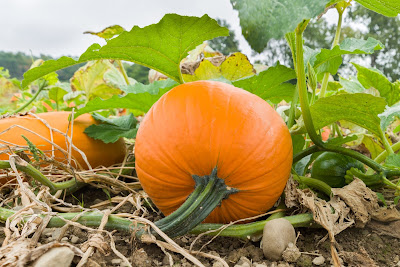Dig In: Garden checklist for week of Oct. 14
 |
| Is this pumpkin ready to pick? The thumbnail test will tell. (Photo courtesy Petr Kratochvil) |
By Debbie Arrington
October is prime pumpkin time, with gourds big and small nearing perfection. These warm days will lengthen the growing season another week or two (as long as the vines have water) while also ripening those prize squash.
But how do you tell when a pumpkin is ready to pick? And, as Halloween nears, how do you speed up the ripening process?
Pumpkins turn orange while still growing, so color alone is not a reliable ripeness indicator. Instead, wait until the shell -- the pumpkin's outer skin -- hardens. (A soft shell makes for a mushy jack-o'-lantern.)
Judging hardness is easy. Use your thumbnail. Gently try to push your nail into the pumpkin's skin. If it dents but doesn't puncture, the shell is hard enough to pick the pumpkin.
When harvesting your pumpkin, use a sharp knife or pruners. Don't try to pull or twist it off; that can damage the pumpkin and tear the remaining vine (in case there are more pumpkins on the way). Keep attached a big piece of stem, about 3 to 4 inches long; that helps the pumpkin last longer off the vine.
Need your pumpkins to hurry up for Halloween? The more sun the pumpkins get, the faster they ripen.
Trim away any leaves shading the pumpkins and clear out any other obstructions so the pumpkins can feel the sun's rays directly as much as possible. Turn the pumpkins, so both sides get warm in the sun and harden up. If no more baby pumpkins are developing, stop watering the vine; that cues the plant to finish ripening its fruit.
Besides pumpkins, plenty of other plants need some attention now. With temperatures forecast in the low 80s all week, this is a great time to get outside and enjoy your garden (while also getting a lot done).
* October is the best month in Sacramento to plant most trees, shrubs and perennials. If you're thinking about garden renovation or additions, act now.
* Dig up corms and tubers of gladioli, dahlias and tuberous begonias after the foliage dies. Clean and store in a cool, dry place.
* Treat azaleas, gardenias and camellias with chelated iron if leaves are yellowing between the veins.
* Clean up the remainders of the summer vegetable garden and compost disease-free foliage.
* Now is the time to plant seeds for many flowers directly into the garden, including cornflower, nasturtium, nigella, poppy, portulaca, sweet pea and stock.
* Plant seeds for radishes, bok choy, mustard, spinach and peas. Plant garlic and onions.
* Transplant cool-weather vegetables such as lettuce, cabbage, kale, broccoli and cauliflower.
* Set out cool-weather bedding plants, including calendula, pansy, snapdragon, primrose and viola.


Comments
Post a Comment